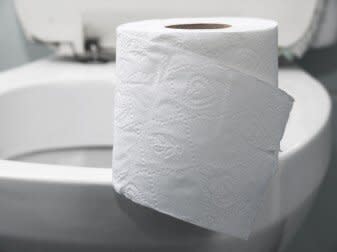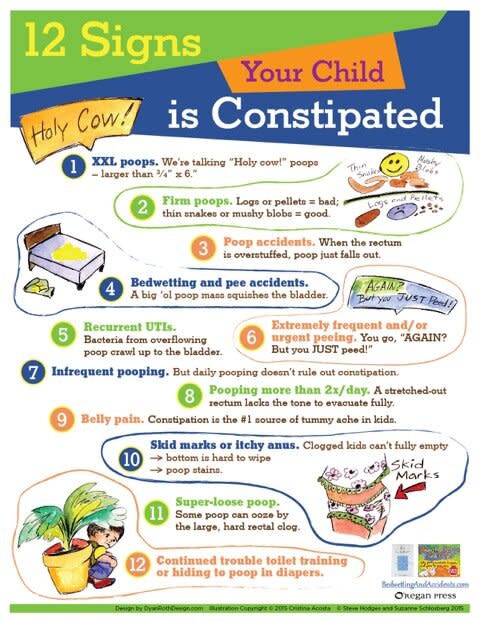The Shocking Danger of Constipation in Kids

Last week brought news that British authorities have been investigating the death of a teenage girl from constipation. That's right: death. The girl's colon became so engorged with stool that it compressed her chest cavity and triggered a heart attack.
RELATED: Is Miralax Safe for Kids?
This story sounds unbelievable—shocking, at the very least.
But you know what? I'm not shocked.
Though I have not, thank goodness, personally seen a case of such tragic proportions, my clinic is booked solid with children whose severe constipation went unrecognized for years.
Many of these children are so stuffed with poop that their bladders are flattened and highly irritated; as a result, they wet their pants daily and the bed nightly. In other children, the rectum has become so stretched that it has lost tone and sensation and poop just falls out—without the child even noticing. I routinely treat 5-year-old girls harboring so much poop that they develop urinary tract infections almost monthly.
The sheer number of these cases is a sign that we in the Western world have a childhood constipation epidemic on our hands. And as with our childhood obesity epidemic, the worst cases are getting worse. Some children's colons have been stretched by giant poop masses for so long that they are in too much pain to eat. In addition to having urinary problems, a small, unlucky fraction of my patients need surgery to remove the damaged segments of their colons.
What's causing the constipation epidemic? As I detail in It's No Accident, I see three culprits:
the highly processed Western diet
our rush to potty train (potty boot camps, driven by preschool dryness deadlines)
ghastly school bathroom conditions and misguided school bathroom policies

Prevention efforts are critical. Parents can do so much by waiting until age 3 to potty train—children trained before 2 have triple the risk of developing chronic constipation—and encouraging physical activity and a whole-foods diet. Once a child is toilet trained, parents must stay vigilant, making certain their children are pooping hefty piles of mush on a daily basis, not pellet or log-shaped stools. Yes, that means peering into the toilet—sorry!
Doctors can do their part by recognizing that bedwetting, accidents, and recurrent UTIs are giant red flags for constipation—rather than telling patients "Don't worry, you're sure to outgrow it" or "You're just a deep sleeper" or "Your bladder just hasn't caught up with your brain" or other common untruths.
By the time patients get to me, we're way past the prevention stage. At this point, aggressive treatment is imperative: a program of daily enemas, accompanied by osmotic laxatives such as Miralax. (Yes, enemas are safe for children, and no, Miralax alone won't cut it.)
What? Daily enemas? Am I insane?
No. I'm recommending a regimen shown by in multiple studies to be highly effective — and proven in my own practice, and that of other physicians, to resolve chronic constipation, UTIs, enuresis (daytime and nighttime pee accidents), and encopresis (poop accidents) far better than anything else. (I call this program the Modified O'Regan Protocol — M.O.P. — after Sean O'Regan, M.D., the pediatric kidney specialist who developed it in Canada in the 1980s.)
An enema regimen will allow the rectum to stay empty, shrink back to size, and regain normal sensation. It is this healing process, more than the initial clean out, that resolves toileting problems.
Enemas are nobody's idea of family fun, and they're not a popular treatment. Even your doctor may consider enemas "overly aggressive" or "extreme." But I submit that any doctor who opposes has not read Dr. O'Regan's research or compared this regimen to whatever he or she currently recommends. (Though enemas are sold over the counter and have an excellent safety record, it's always best to work with your doctor when following an enema regimen to resolve bedwetting or accidents.)
According to news reports, the physician who treated the UK girl who died had prescribed laxatives, and the family had tried various homeopathic remedies. As far as I can tell, nobody thought to prescribe enemas for this child.
Many parents resist enemas because they feel it's not "natural" to place anything inside a child's bottom. My response is this: Carrying around a colon full of poop for years on end, a common scenario these days, is not natural either.
I hope news of the British girl's death will prompt families and physicians to take constipation more seriously.
Steve Hodges, M.D., is an associate professor of pediatric urology at Wake Forest University Medical School and co-author, with Suzanne Schlosberg, of Bedwetting and Accidents Aren't Your Fault and It's No Accident His website is bedwettingandaccidents.com
